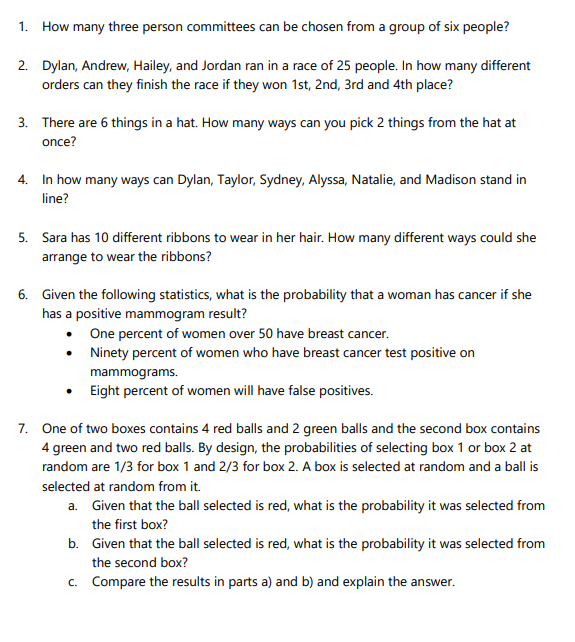2. Dylan, Andrew, Hailey, and Jordan ran in a race of 25 people. In how many different orders can they finish the race if they won 1st, 2nd, 3rd and 4th place? 3. There are 6 things in a hat. How many ways can you pick 2 things from the hat at once? 4. In how many ways can Dylan, Taylor, Sydney, Alyssa, Natalie, and Madison stand in line? 5. Sara has 10 different ribbons to wear in her hair. How many different ways could she arrange to wear the ribbons?
2. Dylan, Andrew, Hailey, and Jordan ran in a race of 25 people. In how many different orders can they finish the race if they won 1st, 2nd, 3rd and 4th place? 3. There are 6 things in a hat. How many ways can you pick 2 things from the hat at once? 4. In how many ways can Dylan, Taylor, Sydney, Alyssa, Natalie, and Madison stand in line? 5. Sara has 10 different ribbons to wear in her hair. How many different ways could she arrange to wear the ribbons?
Chapter8: Sequences, Series,and Probability
Section8.6: Counting Principles
Problem 40E: Choosing Officers From a pool of 12 candidates, the offices of president, vice-president, secretary,...
Related questions
Question
pls answer 2,3,4

Transcribed Image Text:1.
How many three person committees can be chosen from a group of six people?
2. Dylan, Andrew, Hailey, and Jordan ran in a race of 25 people. In how many different
orders can they finish the race if they won 1st, 2nd, 3rd and 4th place?
3. There are 6 things in a hat. How many ways can you pick 2 things from the hat at
once?
4. In how many ways can Dylan, Taylor, Sydney, Alyssa, Natalie, and Madison stand in
line?
5. Sara has 10 different ribbons to wear in her hair. How many different ways could she
arrange to wear the ribbons?
6. Given the following statistics, what is the probability that a woman has cancer if she
has a positive mammogram result?
One percent of women over 50 have breast cancer.
• Ninety percent of women who have breast cancer test positive on
mammograms.
• Eight percent of women will have false positives.
7. One of two boxes contains 4 red balls and 2 green balls and the second box contains
4 green and two red balls. By design, the probabilities of selecting box 1 or box 2 at
random are 1/3 for box 1 and 2/3 for box 2. A box is selected at random and a ball is
selected at random from it.
a. Given that the ball selected is red, what is the probability it was selected from
the first box?
b. Given that the ball selected is red, what is the probability it was selected from
the second box?
c. Compare the results in parts a) and b) and explain the answer.
Expert Solution
This question has been solved!
Explore an expertly crafted, step-by-step solution for a thorough understanding of key concepts.
This is a popular solution!
Trending now
This is a popular solution!
Step by step
Solved in 3 steps with 3 images

Recommended textbooks for you



College Algebra (MindTap Course List)
Algebra
ISBN:
9781305652231
Author:
R. David Gustafson, Jeff Hughes
Publisher:
Cengage Learning



College Algebra (MindTap Course List)
Algebra
ISBN:
9781305652231
Author:
R. David Gustafson, Jeff Hughes
Publisher:
Cengage Learning